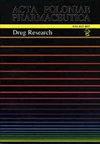The effect of carvacrol upon experımentally ınduced dıabetıc neuropathy and neuropathıc paın ın rats
IF 0.4
4区 医学
Q4 PHARMACOLOGY & PHARMACY
引用次数: 0
Abstract
Diabetic neuropathies are the most frequent complication of diabetes. While numerous metabolic pathways are disrupted in diabetic neuropathy, oxidative stress has been indicated as a significant reason for this condition. In this study, the effect of carvacrol, which has antioxidant effects, on experimental diabetic neuropathy and neuropathic pain was investigated. Alloxan was used to induce diabetes in the experiment. Diabetes was created by administering 120mg/kg of alloxan intraperitoneally (i.p) once a day for 3 days. Rats with a blood glucose concentration above 250mg/kg in the blood taken from the tail veins at the end of three days were considered diabetic. Rats were categorized under healthy control (HG), alloxan-induced hyperglycemia (AG), and alloxan-induced hyperglycemia + carvacrol-treated (ACG) groups. Carvacrol was i.p injected at 50 mg/kg dose to the ACG (n=6) group of rats with hyperglycemia. The same volume of distilled water as the solvent was applied in the same way to AG (n=6) and HG (n=6) rat groups. This procedure was repeated once a day for three months.Carvacrol showed anti-hyperglycemic effect in diabetic rats, protective effect against lowering pain threshold and analgesic activity in rat paws in rats. Carvacrol prevented the oxidant/antioxidant balance from changing in favor of oxidants. The results supported that carvacrol is an agent against alloxan-induced peripheral diabetic neuropathic pain.香芹酚对实验性糖尿病大鼠神经病变和神经病变的影响
糖尿病神经病变是糖尿病最常见的并发症。虽然糖尿病神经病变会破坏许多代谢途径,但氧化应激已被认为是导致这种情况的重要原因。在本研究中,研究了具有抗氧化作用的香芹酚对实验性糖尿病神经病变和神经性疼痛的影响。实验中使用四氧嘧啶诱发糖尿病。通过腹膜内(i.p)给药120mg/kg四氧嘧啶,每天一次,持续3天,产生糖尿病。三天结束时,从尾静脉抽取的血液中血糖浓度超过250mg/kg的大鼠被认为患有糖尿病。将大鼠分为健康对照组(HG)、四氧嘧啶诱导的高血糖组(AG)和四氧嘧啶诱发的高血糖+香芹酚治疗组(ACG)。将Carvacrol以50mg/kg的剂量腹膜内注射给患有高血糖的ACG(n=6)组大鼠。以相同的方式将相同体积的蒸馏水作为溶剂应用于AG(n=6)和HG(n=六)大鼠组。该程序每天重复一次,持续三个月。Carvacrol对糖尿病大鼠具有抗高血糖作用,对降低痛阈具有保护作用,对大鼠爪具有镇痛作用。Carvacrol防止氧化剂/抗氧化剂的平衡发生有利于氧化剂的变化。结果支持香芹酚是一种抗四氧嘧啶诱导的糖尿病周围神经性疼痛的药物。
本文章由计算机程序翻译,如有差异,请以英文原文为准。
求助全文
约1分钟内获得全文
求助全文
来源期刊
CiteScore
0.80
自引率
0.00%
发文量
74
审稿时长
6-12 weeks
期刊介绍:
The international journal of the Polish Pharmaceutical Society is published in 6 issues a year. The journal offers Open Access publication of original research papers, short communications and reviews written in English, in all areas of pharmaceutical sciences. The following areas of pharmaceutical sciences are covered: Analysis, Biopharmacy, Drug Biochemistry, Drug Synthesis, Natural Drugs, Pharmaceutical Technology, Pharmacology and General.
A bimonthly appearing in English since 1994, which continues “Acta Poloniae Pharmaceutica”, whose first issue appeared in December 1937. The war halted the activity of the journal’s creators. Issuance of “Acta Poloniae Pharmaceutica” was resumed in 1947. From 1947 the journal appeared irregularly, initially as a quarterly, then a bimonthly. In the years 1963 – 1973 alongside the Polish version appeared the English edition of the journal. Starting from 1974 only works in English are published in the journal. Since 1995 the journal has been appearing very regularly in two-month intervals (six books a year). The journal publishes original works from all fields of pharmacy, summaries of postdoctoral dissertations and laboratory notes.

 求助内容:
求助内容: 应助结果提醒方式:
应助结果提醒方式:


